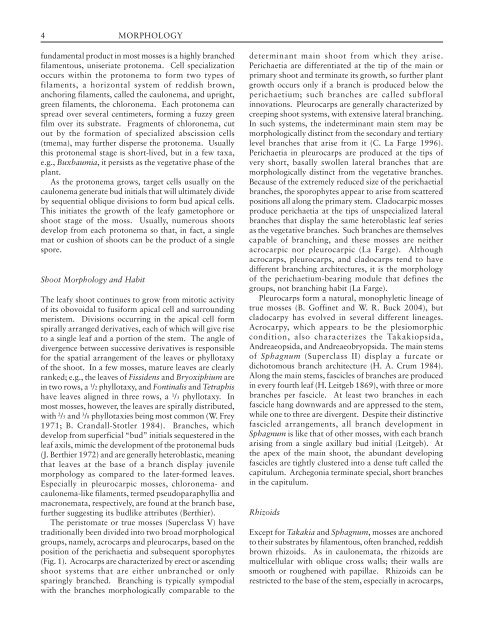Morphology of Mosses (Phylum Bryophyta)
Morphology of Mosses (Phylum Bryophyta)
Morphology of Mosses (Phylum Bryophyta)
Create successful ePaper yourself
Turn your PDF publications into a flip-book with our unique Google optimized e-Paper software.
4 MORPHOLOGY<br />
fundamental product in most mosses is a highly branched<br />
filamentous, uniseriate protonema. Cell specialization<br />
occurs within the protonema to form two types <strong>of</strong><br />
filaments, a horizontal system <strong>of</strong> reddish brown,<br />
anchoring filaments, called the caulonema, and upright,<br />
green filaments, the chloronema. Each protonema can<br />
spread over several centimeters, forming a fuzzy green<br />
film over its substrate. Fragments <strong>of</strong> chloronema, cut<br />
out by the formation <strong>of</strong> specialized abscission cells<br />
(tmema), may further disperse the protonema. Usually<br />
this protonemal stage is short-lived, but in a few taxa,<br />
e.g., Buxbaumia, it persists as the vegetative phase <strong>of</strong> the<br />
plant.<br />
As the protonema grows, target cells usually on the<br />
caulonema generate bud initials that will ultimately divide<br />
by sequential oblique divisions to form bud apical cells.<br />
This initiates the growth <strong>of</strong> the leafy gametophore or<br />
shoot stage <strong>of</strong> the moss. Usually, numerous shoots<br />
develop from each protonema so that, in fact, a single<br />
mat or cushion <strong>of</strong> shoots can be the product <strong>of</strong> a single<br />
spore.<br />
Shoot <strong>Morphology</strong> and Habit<br />
The leafy shoot continues to grow from mitotic activity<br />
<strong>of</strong> its obovoidal to fusiform apical cell and surrounding<br />
meristem. Divisions occurring in the apical cell form<br />
spirally arranged derivatives, each <strong>of</strong> which will give rise<br />
to a single leaf and a portion <strong>of</strong> the stem. The angle <strong>of</strong><br />
divergence between successive derivatives is responsible<br />
for the spatial arrangement <strong>of</strong> the leaves or phyllotaxy<br />
<strong>of</strong> the shoot. In a few mosses, mature leaves are clearly<br />
ranked; e.g., the leaves <strong>of</strong> Fissidens and Bryoxiphium are<br />
in two rows, a 1 /2 phyllotaxy, and Fontinalis and Tetraphis<br />
have leaves aligned in three rows, a 1 /3 phyllotaxy. In<br />
most mosses, however, the leaves are spirally distributed,<br />
with 2 /5 and 3 /8 phyllotaxies being most common (W. Frey<br />
1971; B. Crandall-Stotler 1984). Branches, which<br />
develop from superficial “bud” initials sequestered in the<br />
leaf axils, mimic the development <strong>of</strong> the protonemal buds<br />
(J. Berthier 1972) and are generally heteroblastic, meaning<br />
that leaves at the base <strong>of</strong> a branch display juvenile<br />
morphology as compared to the later-formed leaves.<br />
Especially in pleurocarpic mosses, chloronema- and<br />
caulonema-like filaments, termed pseudoparaphyllia and<br />
macronemata, respectively, are found at the branch base,<br />
further suggesting its budlike attributes (Berthier).<br />
The peristomate or true mosses (Superclass V) have<br />
traditionally been divided into two broad morphological<br />
groups, namely, acrocarps and pleurocarps, based on the<br />
position <strong>of</strong> the perichaetia and subsequent sporophytes<br />
(Fig. 1). Acrocarps are characterized by erect or ascending<br />
shoot systems that are either unbranched or only<br />
sparingly branched. Branching is typically sympodial<br />
with the branches morphologically comparable to the<br />
determinant main shoot from which they arise.<br />
Perichaetia are differentiated at the tip <strong>of</strong> the main or<br />
primary shoot and terminate its growth, so further plant<br />
growth occurs only if a branch is produced below the<br />
perichaetium; such branches are called subfloral<br />
innovations. Pleurocarps are generally characterized by<br />
creeping shoot systems, with extensive lateral branching.<br />
In such systems, the indeterminant main stem may be<br />
morphologically distinct from the secondary and tertiary<br />
level branches that arise from it (C. La Farge 1996).<br />
Perichaetia in pleurocarps are produced at the tips <strong>of</strong><br />
very short, basally swollen lateral branches that are<br />
morphologically distinct from the vegetative branches.<br />
Because <strong>of</strong> the extremely reduced size <strong>of</strong> the perichaetial<br />
branches, the sporophytes appear to arise from scattered<br />
positions all along the primary stem. Cladocarpic mosses<br />
produce perichaetia at the tips <strong>of</strong> unspecialized lateral<br />
branches that display the same heteroblastic leaf series<br />
as the vegetative branches. Such branches are themselves<br />
capable <strong>of</strong> branching, and these mosses are neither<br />
acrocarpic nor pleurocarpic (La Farge). Although<br />
acrocarps, pleurocarps, and cladocarps tend to have<br />
different branching architectures, it is the morphology<br />
<strong>of</strong> the perichaetium-bearing module that defines the<br />
groups, not branching habit (La Farge).<br />
Pleurocarps form a natural, monophyletic lineage <strong>of</strong><br />
true mosses (B. G<strong>of</strong>finet and W. R. Buck 2004), but<br />
cladocarpy has evolved in several different lineages.<br />
Acrocarpy, which appears to be the plesiomorphic<br />
condition, also characterizes the Takakiopsida,<br />
Andreaeopsida, and Andreaeobryopsida. The main stems<br />
<strong>of</strong> Sphagnum (Superclass II) display a furcate or<br />
dichotomous branch architecture (H. A. Crum 1984).<br />
Along the main stems, fascicles <strong>of</strong> branches are produced<br />
in every fourth leaf (H. Leitgeb 1869), with three or more<br />
branches per fascicle. At least two branches in each<br />
fascicle hang downwards and are appressed to the stem,<br />
while one to three are divergent. Despite their distinctive<br />
fascicled arrangements, all branch development in<br />
Sphagnum is like that <strong>of</strong> other mosses, with each branch<br />
arising from a single axillary bud initial (Leitgeb). At<br />
the apex <strong>of</strong> the main shoot, the abundant developing<br />
fascicles are tightly clustered into a dense tuft called the<br />
capitulum. Archegonia terminate special, short branches<br />
in the capitulum.<br />
Rhizoids<br />
Except for Takakia and Sphagnum, mosses are anchored<br />
to their substrates by filamentous, <strong>of</strong>ten branched, reddish<br />
brown rhizoids. As in caulonemata, the rhizoids are<br />
multicellular with oblique cross walls; their walls are<br />
smooth or roughened with papillae. Rhizoids can be<br />
restricted to the base <strong>of</strong> the stem, especially in acrocarps,
















